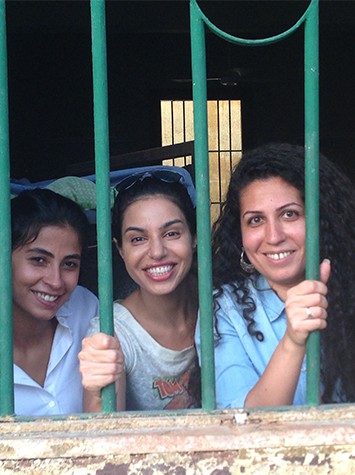One would think that with Egypt’s history with cinema and television, we would have an abundance of brilliant costume designer. Unfortunately, that is not true. However, we’re starting to get glimpses of some very talented designers recently. Reem El Adl is one of those. Her work includes Walad wa Bent, Samir wa Shahir wa Bahir, and most recently, Segn El Nessa. We sat down with her to discuss her work.
Have you always wanted to be a Costume Designer for films and television? How did you come to that decision?
I decided that a very long time ago. My friend, Yasmine Fahmy, needed an assistant. So I went with her and really liked it. I worked with her for a while and then started working alone. After that, I felt like I didn’t have enough experience to work alone. So I worked as Ms. Nahed Nasrallah’s assistant for a year. Then I realized there were too many costume designers and I wanted to be different. So I went to Academia Italiana in Florence and got a diploma in Film and Theatre Costumes.
You graduated from Fine Arts, Sculpting Section. Did you consider working as a sculptor?
No. I studied that because I wasn’t any good in any of the other sections. (Laughs)
Egyptian productions used to neglect proper costume design and styling. Raafat Elhaggan, for example, didn’t look like it was set in the 50s. Why do you think that is?
Because it wasn’t there. This used to be done by Shady Abd Elsalam with the décor team. And it only happened in films that required costumes. In black and white films, you couldn’t see the colors. You can even see in the 70s that the colors were awful. Then in the 80s we didn’t even have proper cinema. Youssef Chahine was the only one who had costume designers. In the early 90s they started understanding designers’ importance. And some people still don’t get its importance until now. This is also because some people use it as a gateway to get into show business.
Things have improved recently for styling and wardrobe. Is it because the public gets its importance now, or is it because good costume designers emerged?
We’ve been doing this for a while. The public, until very recently, didn’t get that. Some very popular movies have horrific historical mistakes when it comes to wardrobe. The first time people noticed my work was Samir wa Shahir wa Bahir. I was very happy about that. That, and Walad Wa Bent. They noticed the clothes matched the 70s, 80s and 90s in this film. However, until now some people don’t notice unless it’s a historical production. In Segn El Nessa people noticed because it was very detailed. People didn’t think anyone would notice small things like nail polish or headscarf pins.
Your work on Segn El Nessa was very impressive. How did you research that?
For starters, it’s set in an era that I lived. So I could picture it well. About the prison, we went there and saw how people dressed. People ask me if they actually wear all that gold, and yes, they do. They wear makeup, too. Some wear diamonds, some wear gold, some wear plastic accessories. I also went to where they lived. So everything was very authentic. Kamla wanted all the actors and actresses to look different. To be fair, it was because Kamla was there. Maybe if the series was done by someone else, I would’ve missed some details. There’s something about her that brings out the very best in everyone.
Each character was not only defined by its job and social class, but also their character. How do you decide what their taste in fashion would be like?
This is how I build a character. I read the script, talk to the director and then draw sketches of the characters. Then I put myself in the character’s shoes. I come up with a background and think who could be their role model. I think of the colors they like, when was the last time they bought clothes, stuff that might not be written in the script.
Is proper styling used enough in Egyptian show business?
We still need time. We don’t even have a prize category for costume design in Egyptian festivals. And until a year ago we didn’t have a section in the union, we were always put with the décor engineers.
I’ve always thought costume design is very important. It could ruin an entire production if done wrong. That’s why I’ve always wanted to do something like Segn El Nessa. I wanted to do something “local” that didn’t look like folklore. I want to know who convinced them that anyone dresses in Nancy Ajram “galabeya” on the street!
Is working with some directors easier than others?
I can deal with everyone. However, there are directors who add to your work and support you when you ask an actor to wear a certain costume. Then there are directors who will do anything the actors demand. I’ve worked with directors like that and I’ve finished my projects with them, but I wouldn’t work with them again.
You’ve worked on diverse shows from Segn El Nessa, to Walad wa Bent, to Samir wa Shahir wa Bahir. Do you have a favorite genre?
I don’t have a favorite. I do have an era which I’ve never done before, and would really like to do in the future; the 50s and 60s. I love its fashion and would love to recreate it. I also love good historical series and local series. I don’t prefer typical modern productions. I enjoy productions that have a good idea behind them.
Do you know what women want?
We want what men want. I’ve always believed that men and women are the same. I didn’t feel like I couldn’t take what was rightfully mine. Maybe others can’t do this, but I can.

